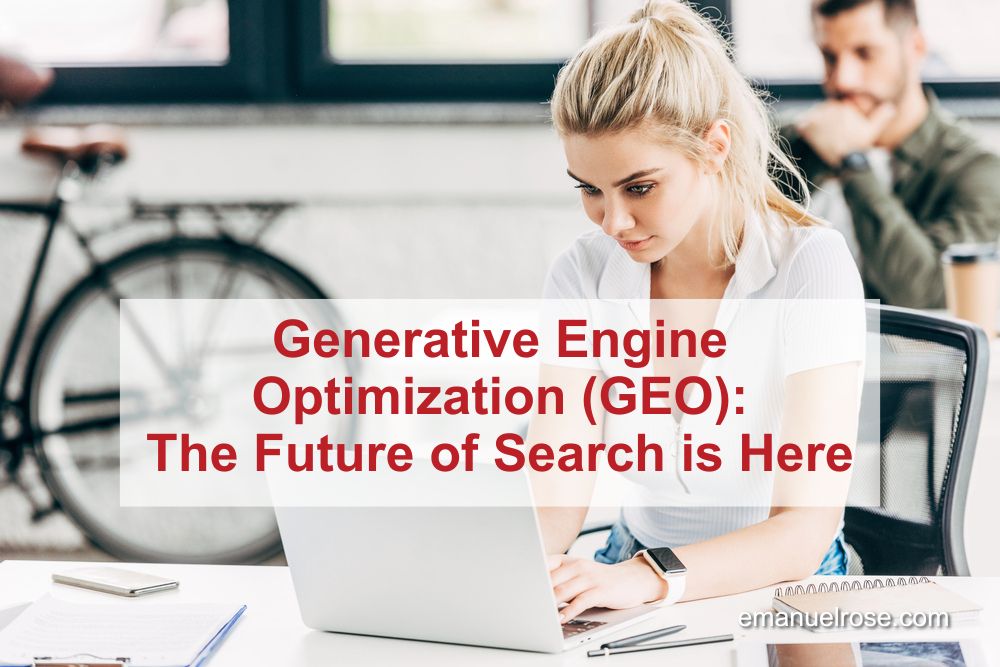When we think about the next big leap in digital marketing, it’s always fascinating to consider how emerging trends and technologies will change our approach. Today, we’re focusing on Generative Engine Optimization (GEO), which represents the cutting edge of SEO as we know it. This concept stems from conversations with industry experts who have spent decades perfecting their craft and adapting to new methodologies.
GEO is essentially the next iteration of SEO, and it builds extensively on the principles we’ve practiced for years, adding layers of artificial intelligence and machine learning to the mix. But how do we make our content more accessible and recommendable by AI tools like ChatGPT, Claude, and other large language models (LLMs)? Let’s break it down.
The Foundation and Next Steps

First off, the fundamentals of modern SEO remain crucial. Keywords, long-tail keywords, latent semantic indexing (LSI), relevant content, interlinking, and social signals still form the bedrock of an effective SEO strategy. Even with the rise of AI, these elements ensure that your website is discoverable, engaging, and authoritative.
GEO, however, takes things a step further. While traditional SEO helps search engines index and rank your website, GEO optimizes it for AI-driven models. It’s about making your content not just searchable but also ‘understandable’ by sophisticated AI algorithms. AI pulls vast amounts of information from the web and seeks to deliver the best possible user experience by mimicking human thought processes. Human oversight remains crucial to ensure that the information presented is accurate and reliable.
Key Components for Adapting to GEO
To adapt to GEO, several key SEO components need to be fine-tuned:
- Authority and Authenticity: Content needs to be well-cited and authoritative. AI models prioritize information that is not just correct but also extensively verified. Adding author bios, citing sources, and linking to authoritative sites help in this respect.
- Structured Data and Schema Markup: Schema markup remains vital. Whether it’s author tags, menu schemas, or product information, structured data helps search engines understand your site contextually and offers richer search results.
- User Engagement: Engagement metrics such as dwell time and bounce rates are critical. AI models evaluate how users interact with your site and prioritize sites that keep users engaged. Multimedia elements like infographics and videos can substantially enhance user engagement.
Linking practices also require attention. External links should direct to high-authority domains like Wikipedia or industry-specific authoritative sources. This adds credibility to your content, crucial for AI-driven engines.
Interlinking your own content to create clusters is another effective strategy. This practice helps organize your content thematically, immensely beneficial for any AI model trying to understand your site’s focus and depth.
Enhancing User Experience and Content Quality
User experience design plays a crucial role in GEO. Websites must be user-friendly, visually appealing, and easy to navigate. Page load speed, mobile responsiveness, and intuitive design are critical factors contributing to an excellent user experience. AI models prioritize websites that offer seamless experiences to users, making UX design an integral part of your GEO strategy.

High-quality content that addresses the needs and queries of users will always be a priority. It’s essential to produce content that is not only informative but also engaging and relevant. Long-form content, detailed guides, and well-researched articles tend to perform better, especially when optimized for GEO. Consistently updating your content to reflect the latest information and trends is also key to maintaining its relevance.
Social signals, such as likes, shares, comments, and mentions, can significantly impact your website’s authority and visibility. Building a strong brand presence on social media platforms and encouraging user interaction can indirectly enhance your GEO efforts. Authentic engagement with your audience on social media can lead to increased traffic and brand recognition, which are important factors for AI models when ranking content.
Staying Ahead with Monitoring and Adaptation
Staying on top of GEO means continually educating yourself and adapting to changes. Follow trusted sources like Search Engine Journal, Search Engine Land, or Search Engine Roundtable for the latest updates and trends. Testing different AI tools and understanding their nuances also help you stay ahead.
Different tools like Gemini and Google Bard, especially for mobile searches, offer unique insights compared to desktop-based searches. Testing various AI tools and understanding their differences can provide a comprehensive view of GEO.

In conclusion, while the basics of SEO are essential, the future lies in adapting to Generative Engine Optimization. It’s not merely about ranking higher but making your content more relevant, authoritative, and engaging for both users and AI models alike. Understanding what GEO is doing, where it’s coming from, and how it impacts your industry is crucial.

